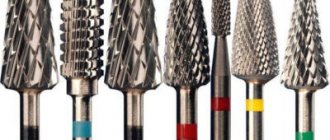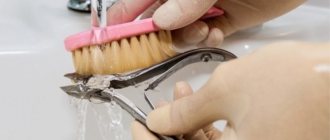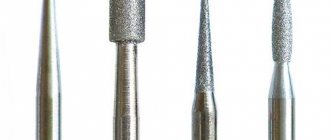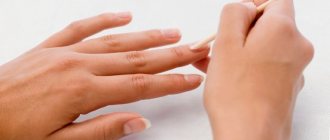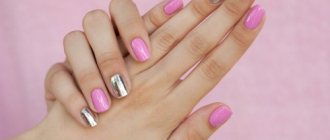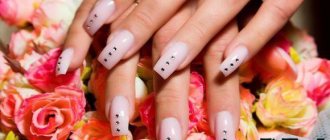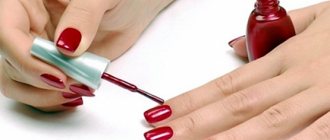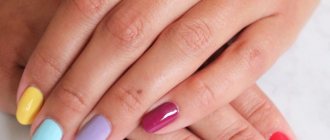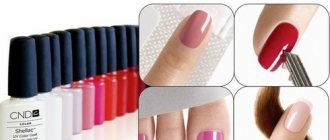Tuesday February 25th, 2020
13891
Sterilization of manicure tools is one of the most important stages of performing a manicure. Neglecting the rules of disinfection and sterilization can affect the health of both the master and the client.
Now no one needs to explain the importance of sterilization. More than 10,000 bacteria settle on human hands per day, fungi and viruses persist. As a rule, the carrier is protected by the skin itself, but when it is damaged, the risk of infection increases tenfold. After a manicure, tools usually contain skin particles, bacteria, and infections. Untreated instruments can transmit serious diseases, including hepatitis or HIV.
Sterilization and disinfection of instruments is primarily aimed at preventing the transmission and infection of the client with a bacterial or viral infection, fungus or other disease that is transmitted by contact.
A master who does not comply with the rules for sterilizing instruments puts not only himself and the client at risk, but also the work of the business as a whole. After all, in case of infection, the salon will bear responsibility.
Also, for any manicurist, his professional tool is extremely important, which should always be clean, sharp and ready for work. This is the second functional task of properly processing a manicure tool - to extend its service life.
In this article we will look at the stages of sterilization of manicure instruments and tell you how to properly process manicure instruments.
We also recommend reading the article “Automate, you can’t have mercy: Save 90 hours a month by managing a beauty salon with Beauty Pro CRM”
Why are manicure kits sterilized and disinfected?
The rules for using manicure accessories are prescribed in SP 3.1.5.2826-10, SanPiN 2.1.2.2631-10. The requirements include 4 stages of processing: disinfection of used items, pre-sterilization cleaning (PSC), sterilization and storage of manicure instruments.
Sterilization of objects for manicure or pedicure is a measure to prevent the spread of infections. Pathogens are transmitted when a contaminated instrument comes into contact with a nail or with blood due to accidental damage to the skin.
According to the requirements of SanPiN, the master is obliged to disinfect his hands (his own and the client’s), workplace, and manicure tools.
Infection is possible through manicure tools:
- hepatitis C or B;
- herpes;
- HIV;
- nail and/or skin fungus;
- pyogenic microbes.
STAGE THREE – STERILIZATION
We pack the instruments in special bags for sterilization . We indicate the contents, date, time of sterilization and expiration date of the sterilized instrument.
Next comes sterilization of the instrument. We must place the sterilization package in an autoclave at 134 degrees for 5 minutes (or another program in the case of gentle sterilization) or in a dry-heat oven at 180 degrees for 60 minutes. To monitor the operation of sterilizers, special external indicators are used; they are placed inside the chamber on a tray at five key points - in the corners and in the center.
Upon completion of sterilization, the sterilization packaging with sterile instruments should be placed in a desktop drawer or in a UV cabinet. The UV cabinet allows you to maintain the sterility of the instrument.
Next, fill out the quality control log of the sterilizer.
Remember that according to SanPiN, you are required to have three sets of tools in order to have time to disinfect the tools.
Methods for processing manicure tools
Sterilize with disinfectants and equipment with a physical and/or chemical disinfection mechanism.
Types of devices:
- for primary disinfection or PSO - ultrasonic baths/washes;
- for sterilization - autoclaves, dry heaters, boilers;
- for storage - bactericidal boxes, ultraviolet sterilizers.
Chemical treatment is done with disinfectants.
Boiling
The method is suitable for heat-resistant hand and hardware manicure items.
Rating of equipment for sterilization by boiling method:
- automatic electric boiler “KDEA 1-4”;
- disinfection electric boiler “E-40-1”;
- disinfection boiler “P-22-1” (for boiling on an electric stove).
Heat treatment is done after primary disinfection, PSO.
Sterilization algorithm:
- Clean items are placed in a boiler container with water.
- Waiting for it to boil.
- Boil for 20 minutes.
- The products are taken out with tongs and dried on sterile napkins.
It is advisable to boil in a 2% aqueous solution of “Sodium bicarbonate”. It increases the boiling point, improving the quality of sterilization.
Autoclave
Sterilization occurs under hot steam pressure with a temperature above +110 ºC. For manicure instruments, buy medical autoclaves of class B or S.
Cost of popular tabletop autoclaves:
- Prestige Medical Classic 2100, 9 l (Gehwol) - 63,500 rubles;
- TANZO C12, 12 l (Woson) - 100,000 rubles;
- STE-8, 8 l (IcanClave) - 103700.
The autoclave is used after primary disinfection, PSO. Disinfect objects that are resistant to hot steam.
Instructions for sterilizing manicure instruments:
- Water is poured into the autoclave, items are loaded, and sterilization indicator strips are laid out.
- They set the temperature and time and turn on the device.
- After processing, the products are transferred to a sterile place.
Manicure instruments are disinfected for 3–15 minutes. The exact duration of sterilization is indicated in the autoclave instructions.
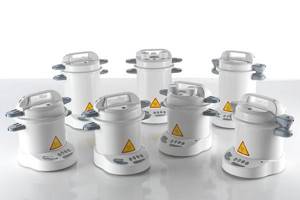
Prestige Medical Classic
Dry heat cabinet
Manicure instruments in a dry heat are disinfected with air heated to a temperature of 180–200 ºC. Houses are treated with household sterilizers or in the oven.
For commercial purposes, dry heaters with Roszdravnadzor registration are used.
Rating of dry heaters for sterilization in the beauty industry:
- TAU Steril 2000 Automatic;
- "GP-20-3";
- "GP-10 MO".
Cabinets are used after primary disinfection, PSO. Manicure tools are placed in craft bags (for sterilization and subsequent storage), then placed in a heated dry heat.
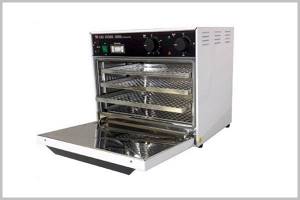
TAU Steril 2000 Automatic
Glasperlene sterilizer
A glassperlene (aka ball) sterilizer disinfects at a temperature of +180–250 ºC in a container with small balls. Processes only the working surfaces of the tool.
Quartz beads must be replaced monthly, otherwise the quality of sterilization will decrease.
Disinfected in a Glasperlene sterilizer after disinfection, PSO, drying. The instrument is immersed in the heated balls for 20 seconds.
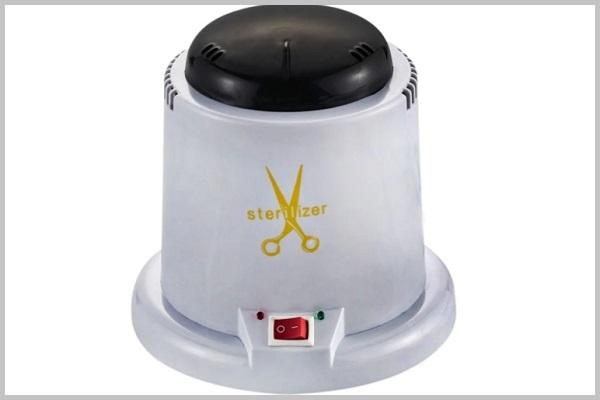
UV and ultrasound
Ultrasonic wash/bath/box - equipment for disinfection and PSO. Disinfects + cleanses using ultrasonic waves. Ultrasonic washers 1200 JP BYU, Eurosonic Micro, Dibea DADI DA-968 are popular.
Features of the use of ultrasonic washers:
- Disinfectant solution is poured into the container.
- Immerse used manicure tools.
- The sink is turned on.
- Afterwards, the product is washed under the tap, dried, and sterilized.
Manicure instruments are stored in ultraviolet boxes after sterilization without Kraft bags. The bactericidal environment in the device is maintained by UV lamps. The rating includes IRISK ZLP-C002, Planet Nails MiniGer, Germix two-chamber, FMX 898-8.
Kraft bags
The bags are used at the sterilization stage.
Products are available for use:
- in dry heat (heat-resistant);
- in autoclaves (do not get wet from steam);
- universal purpose.
The rating included craft packages “Steril” and “PSPV-Sterimag” from Medtest. Products with self-adhesive tape are suitable for autoclaves and dry heaters.
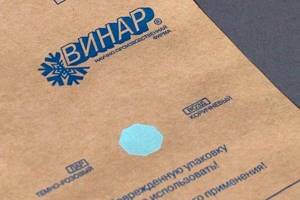
Application of kraft bag:
- Fill out the form on the front side.
- After PSO, the dry manicure instrument is loosely placed inside and sealed.
- The Kraft bag is placed in a dry heat/autoclave.
- To control sterilization, class 4 indicator strips are laid out in the chamber.
- Turn on the device.
After sterilization, the packages are not opened. The instrument is stored inside for 3–60 days, depending on the sealing method.
To watch the video:
Disinfection in solutions
Manicure products are disinfected with disinfectants containing surfactants, HOURS, triamine, guanidine, alcohol and/or an oxygen-containing substance.
Disinfectant solutions can be used step by step:
- primary disinfection (1st stage of disinfection);
- pre-sterilization cleaning;
- sterilization (if the material of the manicure product deteriorates due to high temperature or steam).
Disinfect with a ready-made product or a working solution prepared from a concentrate.
How to use the disinfectant:
- Liquid disinfectant is poured into the tray.
- Immediately after use, the manicure product is immersed in a disinfectant solution. The liquid should cover objects by 1–2 cm.
- After disinfection, the products are washed under the tap and dried. The exposure time is indicated in the disinfectant instructions.
After primary disinfection and PSO, sterilization is performed with equipment or a concentrated disinfectant solution.
See what mistakes it is better to avoid when processing:
What is a Kraft sterilization bag?
Kraft bags for sterilization are very durable, their density is 80 g/cm3. They are resistant to moisture and allow air to pass through microscopic holes in the structure of the packaging material. The permeability of such bags is selective: they are able to allow air molecules to pass through and retain microbial cells, which helps maintain aseptic conditions inside.
Kraft bags for sterilization are made from long-fiber kraft cellulose. It has four to six layers of fiber. This material has been used by postal departments for packaging parcels for quite a long time. Having migrated to other areas of human activity, kraft paper acquired a new form and became an excellent packaging material that preserves the sterility of substances.
The best disinfectants for manicure tools
Use disinfectants against fungus, mold, microbes, and viruses. It is recommended to use disinfectants for PSO, sterilization and disinfection of medical devices.
The best disinfectants with a cleaning effect:
- “Mistral” concentrate - the instructions allow use in ultrasonic washes and manually, suitable for treating a manicurist’s workplace, instruments are disinfected for 30 minutes in a 4% disinfectant solution;
- con - suitable for treating instruments in any way, diluted for manicure products to a concentration of 8%, disinfected for 15 minutes.
"Mistral" or "Alaminol" can be used in everyday life and salons. Suitable for general cleaning, disinfecting clothes and shoes.
Rating of hand sanitizers and manicure tools:
- "Neosteril";
- "Estilodez".
The best means for sterilization, PSO and disinfection of manicure products are called “MultiDez”, “Optimax”. For quick disinfection + PSO, Dezecon is recommended.
Customized Tools
If a metal manicure tool is used by one person, then for your peace of mind you can perform minimal processing:
- Mechanical cleaning from contaminants. To do this, you can use regular soapy water and then rinse everything under running water.
- Disinfection of instruments with an antiseptic. Products for these purposes are easy to find in cosmetic stores, and they will not be exorbitantly expensive.
It should be stored in a closed container so that during the time between procedures it is not exposed to microorganisms from the outside.
It is also worth remembering to disinfect your hands and workplace before performing a manicure. As a rule, the same product as for the tool is excellent for these purposes.

Thus, when used individually, it is enough to keep the instrument clean and regularly disinfect it in order to be calm and not think that if a cut occurs, an infection may get into the wound.
Using disposable nail files
Rospotrebnadzor recommends using disposable manicure products.
Structure of reusable nail files and BAF:
- reduces the quality of sterilization;
- does not tolerate disinfectants and ultrasound;
- wears out quickly.
Disposable saw sets or individual tools are thrown away after use. There is therefore no risk of infection transmission and no costs for sterilization.
Manicurists advise using replaceable Smart abrasives for metal media. Discs or strips are discarded and the base is sterilized.
Types of packaging bags
Kraft bags are so called because they are made from dark kraft paper. And sterilization bags can be made of bleached paper (white). Packaging bags can be of 2 sizes: small 75 by 150 mm, and large 100 by 200 mm. We select the size depending on the size and quantity of the tool. If you are a manicurist and pedicurist, then you may need a large package. Small packages are suitable for lash artists.
What to look for when choosing packages
- What field do you work in?
- For what instruments?
- What type of sterilizer will the processing be carried out in?
basic information
Kraft bags are made from high-strength wrapping paper.
Externally, they are moisture-resistant rectangular envelopes glued on the sides. Color - often brown, less often white. Sealing is carried out using flaps with an adhesive layer or paper clips plus hermetically sealed self-adhesive tape. Another important feature of craft bags is the presence of indicators that change color after heat treatment. It is by these that one can judge the success of the event.
The main function of craft bags is more convenient sterilization of instruments. There are various options for bags that can be used during these types of sterilization:
- steam (autoclave);
- air (tendon);
- combined (autoclave + cabinet, radiation, etc.).
It is necessary to select a package in accordance with the planned type of sterilization.

How to put a tool in a bag
We first open the tool and fold it with the cutting part into the bottom of the bag. When you take it out, you won't get hurt. And also you will not touch the sterile part of the instrument, because... immediately grab your hands. When sealing the bag, you need to run your hand over the bag to remove excess air.
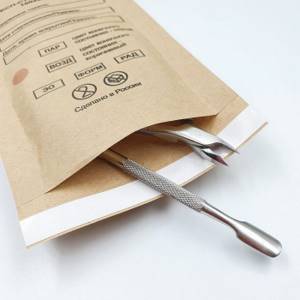
To process instruments, place them in a packaging bag with the sharp edges facing down.
If you have any questions, you can write them to our technologist Olga Volkova.
